

Theshortstopsquat.pdf. Top 10 Deadlifting Mistakes and How to Fix Them. Here's what you need to know...

You can't train the deadlift heavy all the time and make progress. Speed deadlifts with a moderate weight are needed on occasion. Do not round the lower back. This is caused by either a weak lower back or a bad start position. To deadlift more weight, master starting strength, not reversal strength. Tate vs. How to Squat with Proper Form Without Getting Hurt. The Squat is a compound, full body exercise.
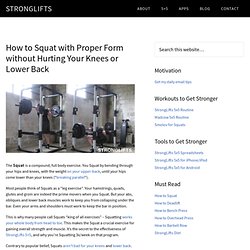
You Squat by bending through your hips and knees, with the weight on your upper-back, until your hips come lower than your knees (“breaking parallel“). Squats- 8 Reasons to Do This Misunderstood Exercise. Fitness: Knees In or Out During a Squat? [Video] Fitness and strength coach Conrad Stalheim moderated a debate on the Breaking Muscle website between those who think having the knees in (valgus) is preferred, and those who believe knees out (varus) is appropriate in a loaded squat.
![Fitness: Knees In or Out During a Squat? [Video]](http://cdn.pearltrees.com/s/pic/th/fitness-knees-during-squat-89749051)
On the varus side, physical therapist and coach Kelly Starrett was present, while the valgus side was supported by Bob Takano, Brendan Murray, Dan Green and a large number of Olympic weightlifters. While there is validity on both sides of the debate, Stalheim points out that the problem may not be whether one should squat with the knees in or out, but rather it is the poor communication between both sides that causes each to be misrepresented. For example, coaches who advocate the valgus movement do not mean that the knee and hip joints are fully internally rotated like someone who just got kicked in the groin. “Only very limited work have [sic] been done in the field of squatting among subject [s] with patellofemoral pain,” said Michael S.
Moderating the Knees In Versus Knees Out Squat Debate. Butt Wink Is Not About the Hamstrings » DeanSomerset.com. Posted July 7, 2014 Squats are awesome.
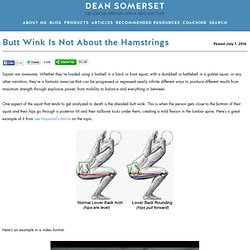
Whether they’re loaded using a barbell in a back or front squat, with a dumbbell or kettlebell in a goblet squat, or any other variation, they’re a fantastic exercise that can be progressed or regressed nearly infinite different ways to produce different results from maximum strength through explosive power, from mobility to balance and everything in between. To Squat Or Not TO Squat: Common Errors in Squatting » Fit Business Insider - Personal Training Business - Fitness Business - Fitness Marketing.
By Eric Cressey I’m going to let you in on a little secret: not all our athletes squat, and the older and more banged up they get, the less they squat.
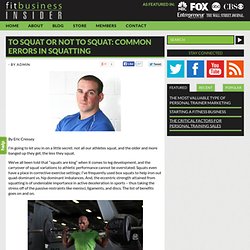
We’ve all been told that “squats are king” when it comes to leg development, and the carryover of squat variations to athletic performance cannot be overstated. Squats even have a place in corrective exercise settings; I’ve frequently used box squats to help iron out quad-dominant vs. hip dominant imbalances. And, the eccentric strength attained from squatting is of undeniable importance in active deceleration in sports – thus taking the stress off of the passive restraints like menisci, ligaments, and discs.
The list of benefits goes on and on. How NOT to RDL. The RDL, or Romanian deadlift, is a staple exercise for Olympic lifters and athletes alike.
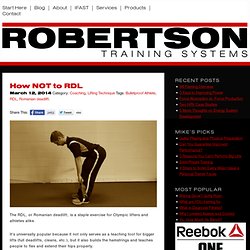
It’s universally popular because it not only serves as a teaching tool for bigger lifts (full deadlifts, cleans, etc.), but it also builds the hamstrings and teaches people to flex and extend their hips properly. However, I will go to my grave saying that the RDL is the single most challenging exercise to teach a rank beginner. The simple notion of locking the spine in while pushing the hips back is incredibly challenging for most, which is why I’ve dedicated an entire blog post to it here today.
Forces and moments on the knee during kneelin... [J Appl Biomech. 2011] How (and Why!) To Do a Jefferson Deadlift - David Dellanave. It’s no secret that I am the world’s biggest advocate of the Jefferson Deadlift (or Jefferson Lift, or Straddle Deadlift, or Jefferson Squat).

In 2012 I set the IAWA world record for the Jefferson at 605lbs. I have personally taught hundreds of people how to do this lift, and written several articles on the topic. I want you to at least try it, because it’s a fantastic lift. Bob Hirsh and his enormous Jefferson of 702 @ 176lbs. My obsession with the Jefferson started a few years ago when Adam T. When I first met Jen Sinkler, she couldn’t conventional or sumo deadlift without pain. Single Set of Squats More Demanding than Bench Press, Triceps Extensions and Lat Pull Down Together! How (and Why!) To Do a Jefferson Deadlift - David Dellanave. The Olympic Deadlift. Here's what you need to know... • The Olympic deadlift is a hybrid of the deadlift and the traditional Olympic clean pull. • What makes this exercise different from the traditional deadlift is that it involves a much greater range of motion.

Think vertical jump, except your feet don't leave the floor. Periodization of Glute-Ham Raise Training. I started working as a strength coach in Denmark (a small country in Scandinavia in Northern Europe) in 1993.
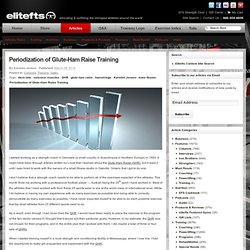
It might have been through articles written by Louie that I learned about the Glute-Ham Raise (GHR), but it wasn’t until I was hired to work with the owners of a small fitness studio in Oakville, Ontario that I got to try one. I don’t believe that a strength coach needs to be able to perform all of the exercises expected of the athletes. This month finds me working with a professional football player — football being the 25th sport I have worked in.
Most of the athletes that I have worked with from these 25 sports were or are at the world class or international level. While I do believe in having my own experience with as many exercises as possible and being able to correctly demonstrate as many exercises as possible, I have never expected myself to be able to do each possible exercise that top level athletes from 25 different sports need to do. How to Front Squat: Everything You Need to Know. Written on December 4, 2012 at 7:09 am, by Eric Cressey The squat is one of the most revered strength training exercises of all time, and the front squat is a popular variation on this compound lift.

However, like many lifts, it's often performed incorrectly, and in many cases used by folks for whom it isn't a good fit. To that end, I thought I'd devote this article to outlining everything you need to know to be successful with the front squat. What Makes the Front Squat Different? Deadlifting with Chains: Why Science Says Chains Work. Maybe you’re a powerlifter and you’re used to hanging chains off your barbell or maybe you’re new to strength training and you’re a little scared of powerlifters and all their toys and contraptions. Either way, you could probably benefit from some science behind the use of chains. A recent study published in the Journal of Strength and Conditioning examined deadlifting and the use of chains. First, researchers wanted to determine whether the deadlift was appropriate to include in explosive resistance training (ERT) protocols, as opposed to more typical exercises used like the jump squat and clean.
Meaning, should the deadlift be done with speed? How to Build a Squat: A Fitness article from Dragon Door Publications. Mark Reifkind, Senior RKC March 17, 2008 04:23 PM. 14 Deadlift Tips and Tricks. 1. Starting with the Hips Too Low This is the king of all mistakes I see. Too many times lifters try to squat the weight up rather than pull the weight. Squat 101 - Juggernaut Training Systems - Juggernaut Training Systems. The squat is the foundational movement to strength and athletic development. For powerlifters, strongmen, weightlifters and CrossFit athletes, success begins in the squat rack; and for athletes looking to sprint faster, jump higher and move more powerfully-great squat mechanics and the strong hamstrings, glutes, quads and hips it develops are critical.
Check out this tutorial on how to squat… I get tons of questions on the Juggernaut Facebook about all sorts of issues regarding the squat. Here are answers to some of the most common ones… 7 Squat Dilemmas Solved. By Bret Contreras – 8/12/2013 Here's what you need to know... • Squatting wide builds the hips and can help you lift more weight, but don't forget about flaring the knees. • Geared powerlifters should go wide. Teaching the Box Squat. By Published:November 14, 2011Posted in: Glutes, Hamstrings, Instructional, SquatsTags: box squat, Brock Newsome, Dave tate.
So You Think You Can Deadlift? (Part 1) Welcome to the long-awaited follow-up to Matt Wenning’s popular “SYTYCS” series. The Deficit Deadlift: A Strength Exercise You Can Do Without. Written on August 15, 2013 at 7:25 am, by Eric Cressey. 7 Squat Dilemmas Solved. You (Still) Don’t Know Squat. 14 Deadlift Tips and Tricks. Smolov Squat Routine. Smolov is a 13 week Squat Program that was developed by Sergey Smolov, the Russian Master of Sports.
It was popularized by Pavel Tsatsouline when he published it in a 2001 issue of Powerlifting USA. Projected gains from Smolov range from 40-100 pounds depending on how advanced you are. It’s fair to say the progress you make from Smolov is only surpassed by it’s intensity and brutality. In case you got all starry eyed and bushy tailed having read the title beware that you cannot get something for nothing. Either of the two four week loading blocks of the thirteen week Russian cycle pack more work than most American squatters do in a year, no joke. This is by no stretch of the imagination a beginners program. Smolov is a super cycle (a long training cycle composed of shorter, but different styles, of training cycles) with approximately five cycles. 19 Squat & Deadlift Variations.
Here's what you need to know... • Variety is good for both strength and hypertrophy and it helps prevent overuse injuries. • Every body is unique, and the best form for a lifter is the one that best suits his unique anthropometry and injury history.